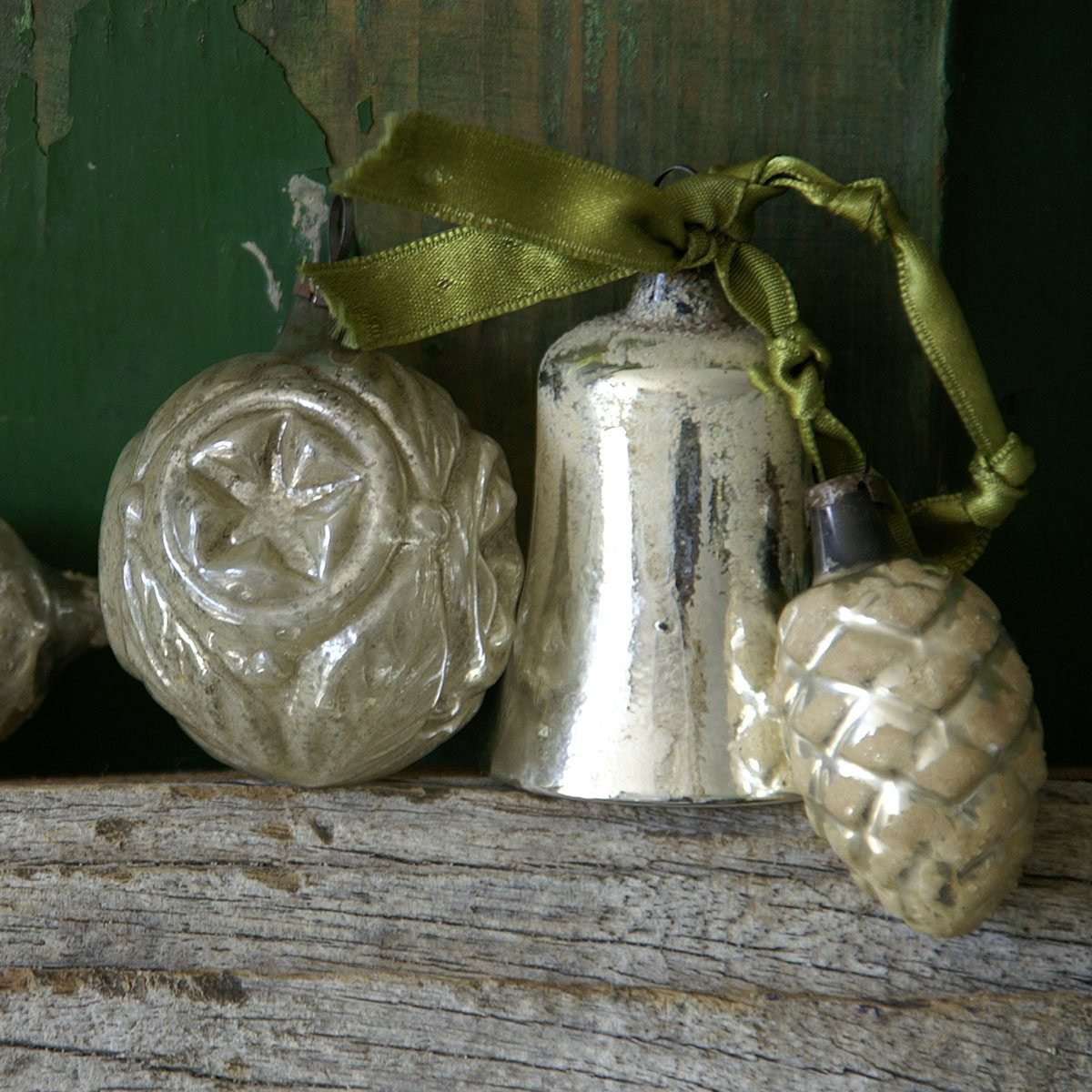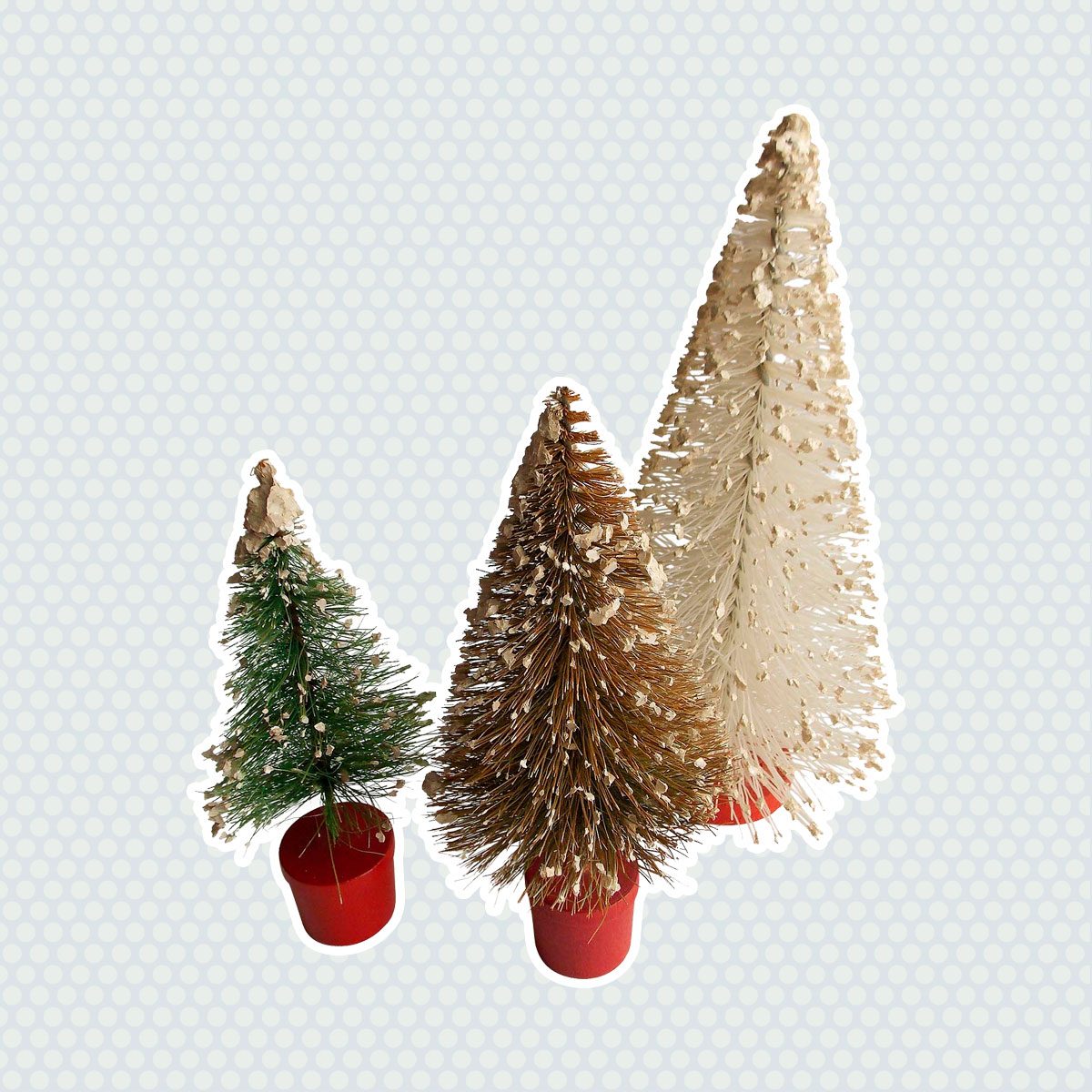
German Kugel Ornaments
Heavy glass ornaments called “kugels,” made in Germany from as early as 1840 to the early 1900s, are prized for their beautiful form and vibrant colors. Though the word means literally “sphere,” the blown-glass ornaments also came in shapes of berry clusters, apples, pears and pine cones. Weighty, they were not painted but lined with silver and treated with just a hint of another metal to yield exotic colors of red, blue, purple, silver and gold. Amethyst, or purple, is considered the rarest. All are topped with detailed bronze caps. Looking to buy vintage gems like this one but don’t have the quad-digit budget? Here are some more incredible vintage Christmas decorations you need to bring back this year.
Worth: Originals sell for $50-300; a rare find can fetch $1,000 or more.

Ceramic Christmas trees
While originally produced in the 1940s, most ceramic trees sold today date from the 1970s and 1980s. Their popularity has recently surged, increasing their value. Dating vintage ceramic trees can be tricky, as they were often handmade, and the mold date may not be the same as the date the tree was made. Decorating is made easy with these fun and festive alternative Christmas trees.
Worth: $35-$250 depending on size, color and condition

Bubble lights
The National Outfit Manufacturers Association began selling branded holiday light sets in 1926. The company was responsible for a number of innovations in its field, and in 1946, introduced the popular bubble light variation. We’re so used to our modern holiday lights, seeing something like this can be a bit jarring. Here’s what Christmas looked like the year you were born.
Worth: Around $75, in original box and in safe working condition

Expandable Christmas scenes
Constructed of lightweight, inexpensive wood, these clever vintage Christmas decorations often feature snowmen, angels or Santas. Generally just marked “Japan,” they were manufactured after World War II for export to dime and department stores. Do you know the secret meanings behind these classic Christmas ornaments?
Worth: $10-$20

Putz houses
Based on a German tradition, these little cardboard houses were often made in Japan and sold in U.S. dime stores from the 1920s through the 1960s. New manufacturers have been inspired by their current popularity and instructions for creating your own abound online. Value depends on size, condition and complexity.
Worth: $10 for simple single houses; $25 and up for the ones pictured

Bottlebrush trees
Mass-produced for such dime stores as Kresge and Woolworth, bottle brush trees look great in large, color-sorted groups, as well as in small vignettes or tied to packages. The ones pictured were probably made in Japan during the 1940s and 1950s. Make your own Christmas ornaments this year with our DIY guide.
Worth: $10-$15 and up, depending on size, condition and detail

Hard plastic candy containers
These fun novelty containers were made by the School House Candy Co., also known as ROSBRO Plastics, in Pawtucket, Rhode Island, and were sold by the millions in the 1950s and 1960s. Once the candy was gone, the containers could be reused as ornaments. These vintage Christmas food ads are guaranteed to take you back.
Worth: $5-$35

Gurley candles
These holiday favorites were manufactured beginning in the late 1930s using excess paraffin produced in the oil refinery process. Designed by candle maker Franklin Gurley and sold as singles or sets, they were actually marketed as small wax figures for display rather than as candles meant to be burned. These retro holiday traditions seriously deserve a comeback.
Worth: $5-$10 and up

Vintage sleds
Samuel L. Allen patented his Flexible Flyer in Cinnaminson, New Jersey, in 1889. “Flexible” applies to both the sled’s steering capabilities, which offered greater control than traditional gooseneck sleds or toboggans, and the fact that riders could use the sleds either seated or lying down. Sales were slow until Allen began marketing the sleds to department store toy buyers. The Flexible Flyer pictured here dates from the 1930s. No matter what era it’s from, a sled is a sled.
Worth: From $35 to several hundred dollars

Royal Ruby glassware
This was the first glassware produced by the newly formed Anchor Hocking Glass Co. in 1939. Like the company’s Forest Green line, this glassware remains popular for holiday table settings. Be on the lookout at estate and garage sales for deals, as rare pieces can command more than $50. These cool Christmas ideas will make your holiday merry and bright.
Worth: $6 for a water tumbler, around $20 for a 5-piece place setting

Free-blown Italian glass ornaments
The Soffieria De Carlini company has made free-blown glass ornaments since 1947, when a well-known sculptor decided to use his talent to “sculpt” glass figurines, which were then individually hand-painted and fancifully decorated.
Worth: $20-$50 per ornament depending on type and condition
The post 11 Vintage Christmas Decorations That Are Worth Money Today appeared first on Taste of Home.
Joe Kenz